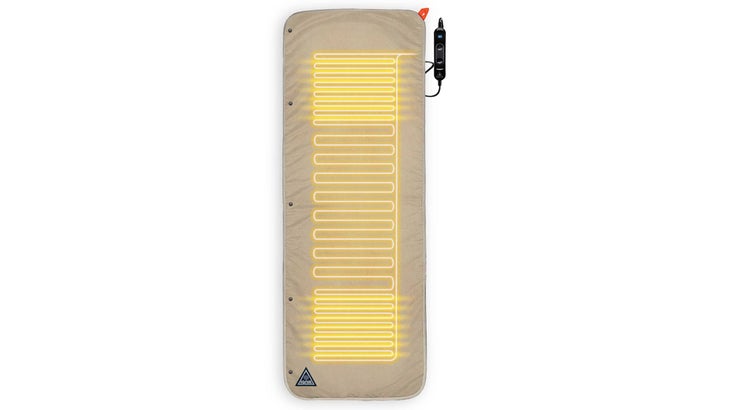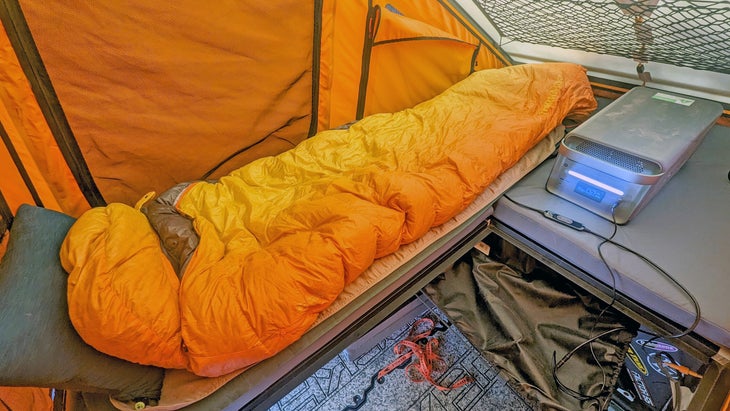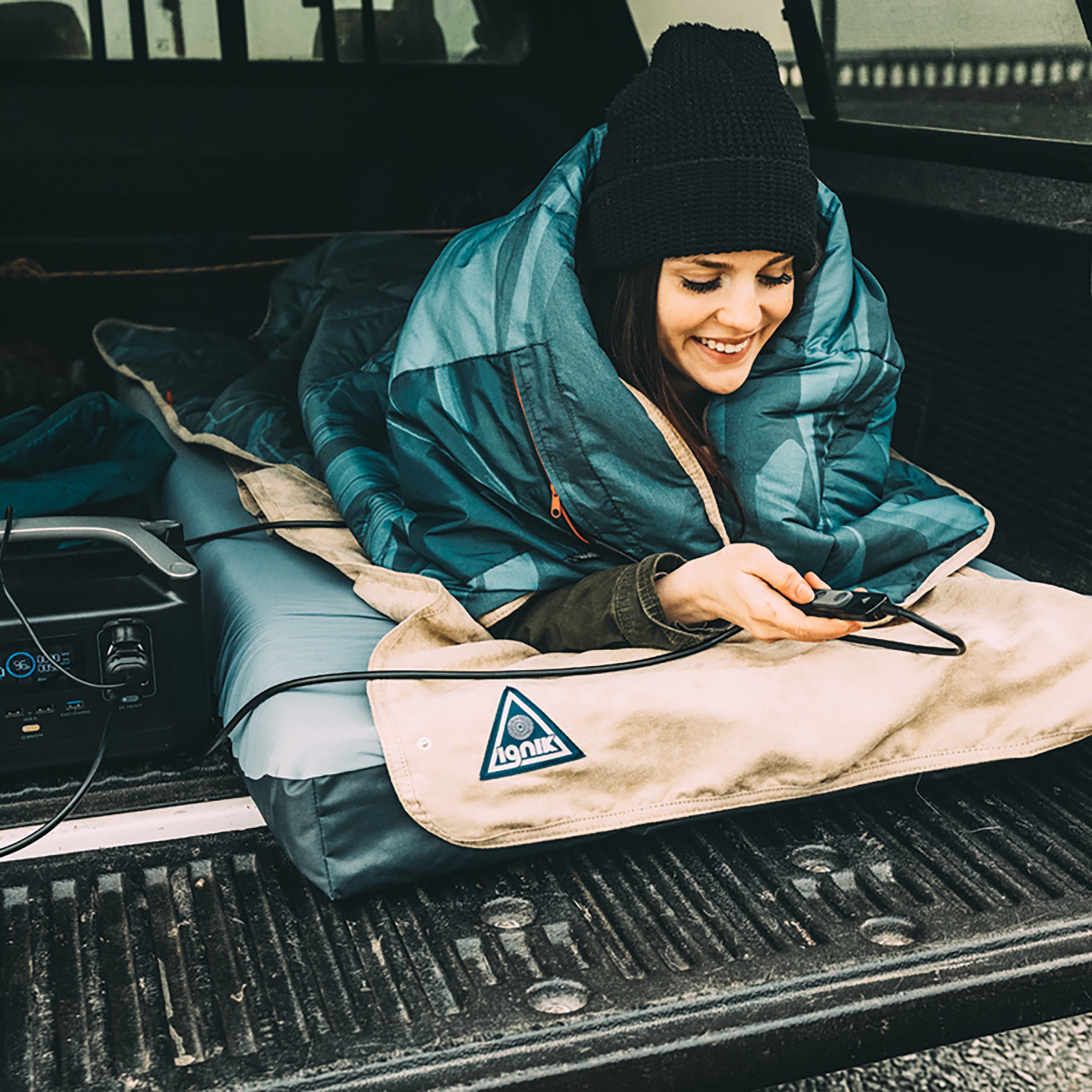I’ve spent years trying to find an effective, efficient, safe way to heat a tent while camping out of my truck. Finally, I think I may have found one. Ignik’s new ($150) provides a level of coziness never before possible, with only one major caveat—it requires an external power source.
To fully explain the appeal of this new solution, let’s first recap the problems with other heat sources.
Propane is very energy dense, and available in portable, refillable formats. You can carry a lot with you, without much effort or cost, and obtaining more is also easy. But, combusting it produces equal amounts of heat and moisture, along with carbon monoxide. Leave a propane heater running while you sleep, and you run a significant risk of just not waking up in the morning. But, turn that heater off, and you’ll find everything in your tent positively soaked. You actually end up sleeping colder with a propane heater than you would without.
Diesel fuel is also energy dense, and air exchange heaters that burn it blow dry, safe outside air over a heating element before directing it into your tent or camper. So long as you take the time to run the heater’s exhaust pipe well away from your sleeping area and the heater’s intake, you’ll probably live through the night. The trouble is, you also have to take the time to jet the heater for the precise altitude you plan to camp at, then also transport the smelly, oily fuel in your vehicle, and wire up a power source. The result might be dry, safe heat, but achieving that involves a ton of weight, space, time and hassle.
Wood burning stoves are the best solution I’ve found. But the only ones that work well enough to be worthwhile are large, heavy steel items, and taking full advantage of one requires housing it in an even larger, even heavier canvas wall tent. The 32-pound ($380 with necessary accessories) housed in my 37.5-pound 13×13-foot ($2,434) is an amazing solution for long-term, fixed location winter camping, but isn’t really something I’m going to drag along if I’m breaking and setting up a new camp every night, or traveling through far away places.
I have found that running ($26) designed for an office cubicle can take some of the chill off inside my ultralight truck camper. But a lot of what little heat it produces gets wasted, and running one for more than a few hours requires the use of a large, expensive battery pack, and if you want to feel any benefit from the little guy, you have to run it for an hour or so before you go to bed, then keep it going all night.
Which brings us to heated blankets and mattress pads. There’s been options around for a while, but 110-volt items are designed for home use—where power is essentially limitless—and are anything but efficient as a result. Existing 12-volt pads are designed for long-haul truckers who permanently install them on the beds in their truck cabs. They come with explicit instructions not to fold, roll, or pack them down in any way—doing so can cause an electrical short, which could start a fire.

Enter Ignik’s new . It’s safe, uses a relatively small amount of power, and is designed to stand up to the real world abuse of camping. It’s only about a quarter-inch thick, rolls up into a package about as small as a roll of paper towels, and weighs maybe a pound or so. I spent three nights sleeping on top of one inside my GoFastCamper last weekend, and have rarely felt so cozy.
The Flipside produces 48 watts of heat on its highest setting, which Peter Pontano, Ignik’s director of product development, explains, “Is equivalent to about half the heat a human body produces. So you’re adding 50 percent more warmth to any sleep system.”
Laying on top of the Flipside, you can feel the heat radiating into your body and warming your sleeping bag. On higher settings and in cold ambient temperatures, the pad feels hot to the touch. An attached controller allows you to run the mattress pad anywhere between 10 and 100 percent, and set a run time of up to 10 hours.
Versus a space heater–electric, propane, diesel or whatever–the pad is able to provide heat more effectively, more efficiently, since it’s warming only your body and sleeping bag.
Pontano explains that quoting an exact temperature number for an electric heat source is difficult. While the silicone-coated braided copper wires threaded through the faux-suede pad may get as hot as 95 degrees Fahrenheit, that heat is diffused through both the pad fabric, and by ambient temperatures. “It’s not like a thermostat on your furnace at home telling you an air temperature,” he says.
Ignik is able to achieve that level of warmth by taking advantage of the large capacities and high amperage available from modern battery packs, which are becoming nearly ubiquitous among car campers. While the starter battery in your car may hold around 700 Wh of energy, they typically require at least half that capacity to turn your engine over in the morning, giving you only enough power to run the Flipside for most of a single night. Portable battery packs commonly now hold many times that, and operate entirely independent from your vehicle. The ($3,300) I’m currently using, for instance, packs 2,611 Wh, enough to provide 54 hours of max heat on the Ignik. That’s enough to run the pad at its maximum setting for eight hours a night, seven nights in a row.
“We really see these heated sleep systems as accessories for modern battery packs,” explains Pontano. You’ll need one with around 300 Wh of capacity per night you plan to use it with the pad, between charges. That’s the caveat.
That’s in addition to any other gadgets you’re using that battery to power or run. Battery packs are becoming common as more of us bring fridge-freezers, lights, drones, cameras, and other electronic items along outdoors. Heated sleep systems provide one more use case for those batteries; whether or not their price is justified by sleeping warmer will very much differ between individuals.
Portable battery packs require an additional caveat themselves: cold temperatures. —which uses innovative solid state technology to make its batteries smaller, lighter, safer, and faster to charge—says the minimum internal temperature at which its products will provide power output is 14 degrees, and the coldest internal temperature at which they’ll charge is 32 degrees. Other brands will be similar. Some capacity will be lost to thermal management in cold weather, and batteries may not work in very low temperatures. Move the batteries inside the heated passenger compartment on your vehicle to charge them while you drive, and consider storing them inside a cooler (with the necessary cords running out a drain port) while in use, to make the most of the heat they produce while operating. Experiment with such setups at home before relying on battery packs through very cold temperatures outdoors.
You will find other items of heated clothing and camping gear that require only a USB port, and one of those small, cheap portable batteries designed to recharge your phone. Those products are typically not powerful enough to feel warm to the touch and manage run times proportional to their smaller battery packs’ tiny capacities. In contrast, the Flipside provides heat across its entire surface area, with five times the wattage or more.
Ignik is also producing a heated blanket, called the , which retails for $200. It also produces 48 watts of heat and operates similarly to the Flipside pad. But, because heat radiates upwards and the human body typically exhausts a lot of energy counteracting conductive heat loss from below, the Flipside will prove more efficient at providing all-night sleep comfort, so long as you combine it with a sleeping bag appropriate for the conditions. I see the Topside blanket as more appropriate for providing short term comfort around camp.
Both the Topside and Flipside use strong, protected wires fitted with thermostats and resistance meters at multiple points throughout their construction. Pontano asserts that this virtually eliminates the potential for electrical short, and makes them safe to use throughout the night.

I switched the Flipside on for the first time last Friday, about 10 minutes before I climbed into bed. Ambient temperatures in the mountains were in the low 30 degree range. In those few minutes, it grew warm to the touch, and thoroughly heated the sleeping bag I’d thrown atop it. Climbing into the bag stripped of clothing felt immediately comfortable and inviting, with none of the initial shivers the first few minutes on a chilly night typically involve. I verified the pad was drawing precisely 48 watts on my battery’s display, switched off the lights in my camper, and almost instantly fell asleep—something I almost never do. At some point an hour or two in, I woke up feeling a little too hot inside my zero-degree bag, so groggily reached for the pad’s controller, and switched it off. Seven hours after I turned in, I awoke to a 5:00 AM alarm feeling completely rested, with much more energy than I’d typically have at that hour. Warm and relaxed, the brief period between sleeping bag and clothes even felt less chilly.
What gave me that extra-restful sleep wasn’t just the feeling of warm coziness the pad provides, but also the result of a simple equation. With 48 extra watts of heat energy radiating across my entire body and up into my sleeping bag, my body had to exert that much less energy to remain warm.
The heated pad provides one more important benefit. Actively putting heat into your sleep system will help dry clothing layers and even a damp sleeping bag, should extreme conditions cause you or your stuff to get wet. And that could mean more than just comfort in very cold or very wet weather.
Yeah, you need an expensive battery pack to run Ignik’s heated pad, and you’re only dragging along one of those batteries in a car or truck, but so long as you can justify that item’s cost within your total camping setup, then the Flipside is going to significantly improve the quality of sleep you get outdoors in cold weather.


